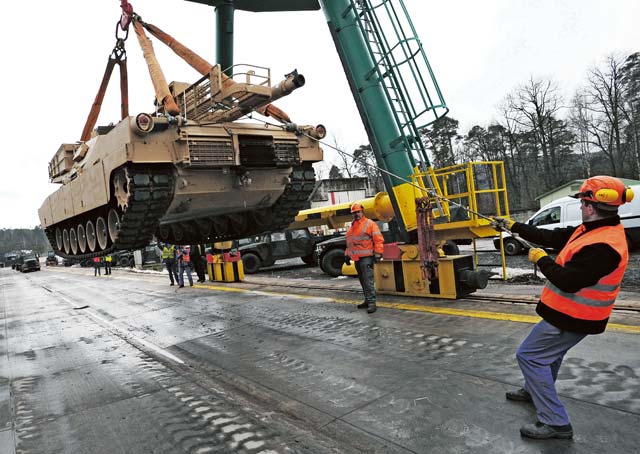
The last 22 Abrams main battle tanks assigned to U.S. Army Europe armored combat units began the final portion of their journey back to the U.S. at the 21st Theater Sustainment Command’s Theater Logistics Support Center-Europe railhead March 18 to 20 in Kaiserslautern. This ended a 69-year history of U.S. tanks in Germany.
The tanks arrived at the railhead in the early hours of March 18, and the members of TLSC-E had 24 hours to get them ready to move.
Host nation civilians worked 12-hour shifts to get each tank inventoried, marked, secured and fastened. Each step in securing the tanks was crucial for the trip.
“These tanks must be meticulously accounted for and secured to their rail cars,” said Jurgen Mohrhardt, the railhead branch manager for the Supply Activity Europe, TLSC-E. “We are here to ensure these tanks are properly retrograded and accounted for. We want them to make it back safely to the United States…the team here did an amazing job getting them ready to move.”
To ensure the physical security of the tanks on their journey, six military police Soldiers from the 21st TSC’s 18th Military Police Brigade accompanied the train to the port of Bremerhaven, Germany.
At Bremerhaven, the 22 tanks were loaded on to a vessel called “The Honor of Arc,” an American roll-on, roll-off vessel that allows vehicles to drive onto the deck as opposed to loading them with a crane. Charleston, S.C., was the destination of the tanks and four of the military police escort detail.
“It is an honor to be one of the Soldiers escorting the last battle tanks out of Germany,” said Sgt. Jeremy Jordan, a military police NCO assigned to the 529th Military Police Company. “As these tanks sail back to the U.S., we are closing a chapter in history.”
The U.S. Army first brought tanks to the European continent in 1944, beginning in France with D-Day. By September 1944, the first tanks from the 5th Armored Division had made it into Germany. After World War II, the majority of the Sherman tanks used were sent back to the states.
During the Korean War, a new surge of tanks entered Germany to act as a defense force for Western Europe from the Soviets. Tanks remained in Germany throughout the years to deploy in support of missions in the Middle East. At its peak, Germany was home to 20 armored divisions, which amounts to approximately 6,000 tanks.
“There have been tanks in Germany since 1944, and now there are none,” said Andrew M. Morris, Ph.D., the U.S. Army Europe historian. “For most of that time, the U.S. was a tank heavy Army. This marks the end of an era, both for the armored history in Germany and the U.S. military.”
“Moving these last 22 tanks symbolizes a change in war-fighting methodology,” said Ingrid Boger, the TLSC-E public affairs officer. “This is the end of a long tradition and history of having battle tanks in Germany.”
The last tank to load the vessel was the “Casa Loca,” or The Crazy House. As the single-metric-ton war machine climbed the ramp onto the vessel, it signified the end of an era in Germany, Morris said.
“It’s a major change in orientation from being a heavy force oriented on the defense of Western Europe to a deployable expeditionary force able to go anywhere,” Morris said.


